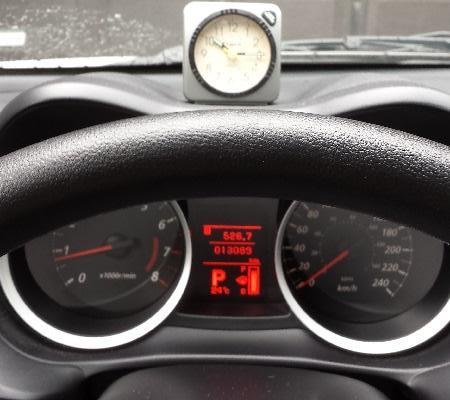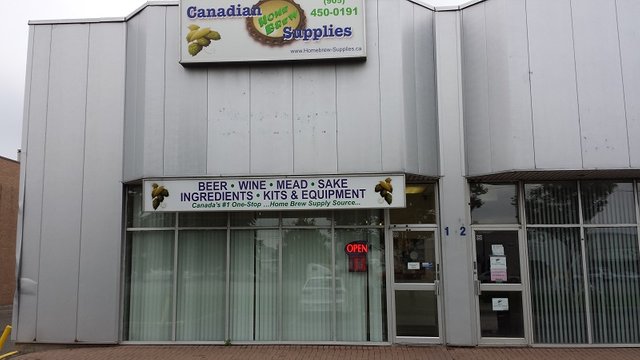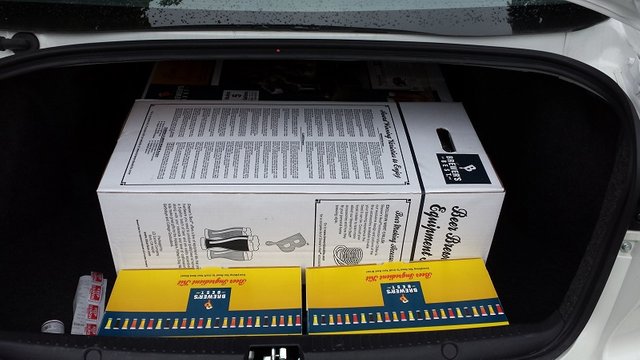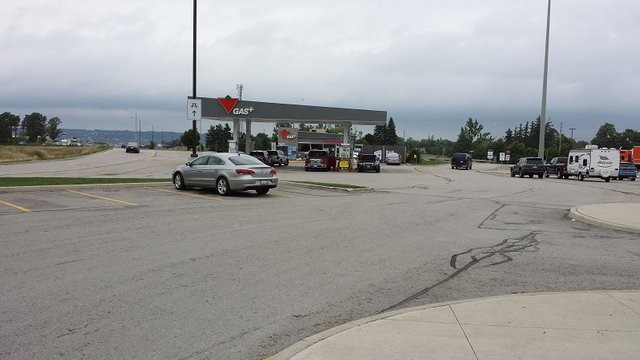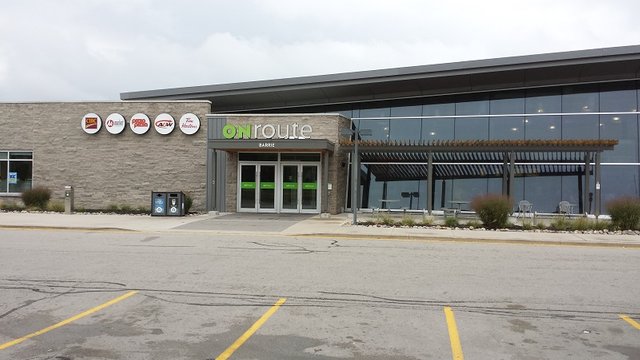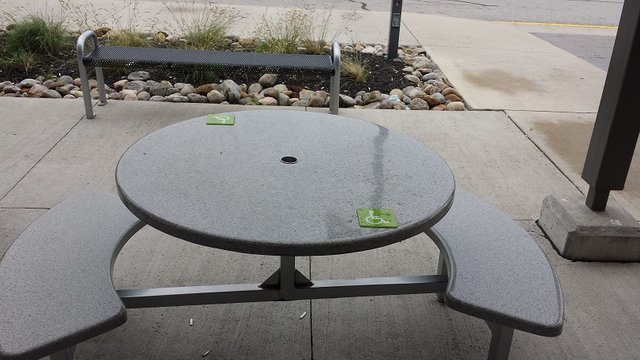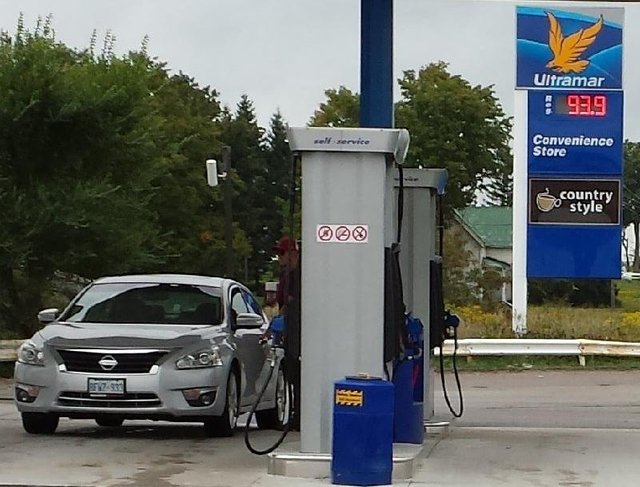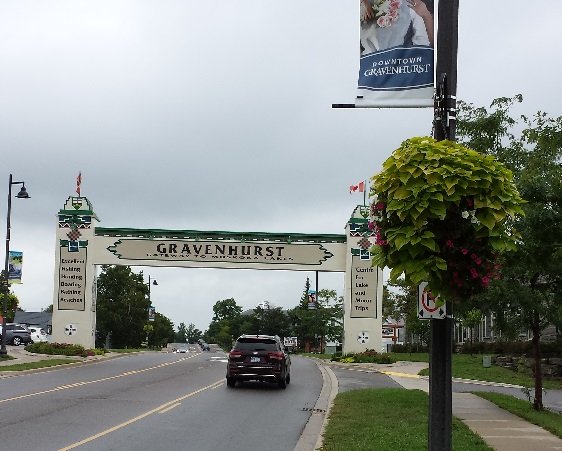Maniac Roadtrip, Part 1: A Necessary Errand...
What would you say about a fellow who put more than eight hundred miles on a rental car in less than twenty-four hours? A maniac, right? I'm your maniac. Thanks to Ontario's huge area, I racked up 1,308 km - 817.5 miles - in a sometimes-wild journey from my home town of Toronto to a small sleeper town near Kirkland Lake and then back to Toronto in eighteen hours of straight driving. As you'll find out later in this series, not in the best road conditions either...
From Toronto To Beer
I started off last Saturday, ready to go at 9 AM, but Murphy's Law intervened. By the time I checked in, had the car in my possession and was ready to go, it was after 10:15 AM:
and I was ready to head out to a beer-making store in Brampton. Tucked into an industrial-park-type strip mall, it was a welcome sight:
as the friendly folks there had just what I was looking for:
Not one beer kit - that would have been too moderate - but two. Ready to make five gallons of suds each. Just add effort and the water; wait patiently.
Sense Of Direction
At this point, I had clocked only 34 km or a little more than twenty miles. A piddle.
But it was challenging in its way, as I drove into one of those old snares that have bedeviled drivers of the male persuasion for decades. I tried to make my own shortcut.
Specifically, I was trying to get onto Highway 400 for the main leg. Like most "man-cuts," this detour relied on my memory - which proved to be not all that good. The metropolitan avenue I was sailing along was Steeles Ave. It did offer a way onto the 400 - but only southbound. Since I was headed northwards, not all that good. So it was up to Highway 7 and onto the 400.
On Block
The 400 is the main drag between Toronto and Barrie, and is now a big commuter's highway for folks who bought houses in or below Barrie: the houses there are much less expensive than Toronto's digs. But long ago, it was the main route to what we Torontonians call "Cottage Country." The tradition continues, as the normal speed of traffic is about 15 km/h (~10 mph) above the speed limit of 100 km/h (~60 mph.) After Highway 7, it's a six-lane strip whose fast lane sees cars travelling above 120 km/h or 75 mph. I've had to pull into the center lane while going above that speed because a faster driver began to ride my tail. It's really not that big a deal: I figured out shortly after I got my license that it was best to let the faster guy go ahead. If there's a traffic cop in wait, he's going to be nabbed instead of me. If not, he'll act as a kind of insurance.
There's another tradition that makes driving quirky. Although the slowest drivers typically drive in the right lane, the slowies on Highway 400 usually drive in the center lane. When traffic is light, the slow lane doesn't contain that many cars at all. This creates an unusual opportunity for Mr. Zippity to use the slow lane as a special passing lane when he's trying to get ahead of some uncooperative driver who's holding back the fast lane by driving a mere 75-80 mph. ;) But you have to be careful, and watchful, as some slow-driving folks do adhere to normality by driving in the right-hand lane. So do transport truckers.
The above describes the 400 when traffic moves smoothly. Since it's so crowded during the day, even a minor traffic block is enough to get it as clogged as a superhighway outside Los Angeles. Funnily enough, when traffic grinds to a crawl the slow lane tends to move the least slowly. That's because it's the lane with the fewest cars. Mr Zippity can get a real leg up by switching to the slow lane when the sea of brake lights ahead tells you that it's time to ease up on the tailgating.
As part of servicing this mighty flow of the 400, there are two pairs of gas stations with minimalls that go under the cutesy name of ON Route. They're well-designed in terms of traffic flow, to the point where someone like me has a bit of a challenge ahead if he ignores the direction signs. The gas station looks like any other off-the-highway instance;
the uniqueness comes with the minimall, housed in a building that looks...standardized:
Inside, it's essentially a food court with vending machines. There are also washrooms. Since these places seem to be a co-operative effort between the sellers and the Ontario government, I feel no guilt when using the washroom without buying anything :)
One interesting feature is the handicapped-accessible picnic tables outside:
Their design is really neat. They're almost as easy to put together as a standard picnic table, and all of them provide at least one place at the table for someone in a wheelchair. The design is classic good engineering: accommodating a new class of folks in a design that's both straightforward and not that different from the old standard (thus making it also straightforward to retool the table-making machines to manufacture them.) I like to imagine that this neat design was hatched by an engineering student who won a prize for it; if so, it's a prize well earned.
Not-So-Hidden Gas Bargain
As we Canadians ruefully know but fatalistically accept, gasoline in Canada is more expensive than in the U.S. When I started my trip, Toronto's busiest gas station charged C$1.03 per litre for the cheapest non-diesel blend. Since the Canuck buck is about 76 cents U.S., and since 1 American gallon is about 3.8 litres C$1.03 per litre is about US$2.97 per gallon. The car rental shop offered a buy-the-tank "special" price of C$1.00, or about US$2.89 per gallon.
One of the more poorly-kept secrets of cottage-country driving is the fact that the highway stations north of Barrie offer prices a few (sometimes several) cents per litre below Toronto prices. The differential is sometimes high enough to actually make it worthwhile to drive a truck up to "Gasoline Alley" with several barrels in the back: empty on the way up, full on the way back. If you're a Torontonian who's brave enough to put a major fire hazard in your backyard, a bulk buy of >1.000 litres of gasoline can actually save you enough to pay for the gas used on the trip. Thanks to some foreknowledge plus a little gentle swerving, I managed to land one of the lowest prices on the route north of Barrie:
C$0.939 per litre; six cents less than what the car-rental company was offering. Thanks, Ultramar, and thank you Gasoline Alley!
Entrance To Cottage Country
Although some folks in the area will dispute it, the entry town to Cottage Country is a town called Gravenhurst. Between Barrie and there, the main drag turns into a four-lane highway named Highway 11: it's the second-longest highway in Ontario. The 400 doesn't end at Barrie; instead, it peels off to form an alternate route. The standard for gettin' northbound is the 11.
It took me about two hours on the 400-to-11 before I saw this welcome sign:
that told me I was entering the "real" Muskokas Not that far away from my second destination...
